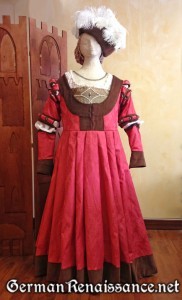 Several years ago I purchased 8 yards of beautiful pink damask fabric in 100% cotton. On a separate fabric buying trip, I found a lovely shade of brown velveteen, also 100% cotton. I held onto both, waiting for just the right way to use these yummy fabrics. Little did I know I’d wake up one morning with the bright idea to use the pink damask and brown velveteen TOGETHER to make a style of German dress I’d yet to try. The result was delicious! Gregor calls it my chocolate-covered strawberry gown.
Several years ago I purchased 8 yards of beautiful pink damask fabric in 100% cotton. On a separate fabric buying trip, I found a lovely shade of brown velveteen, also 100% cotton. I held onto both, waiting for just the right way to use these yummy fabrics. Little did I know I’d wake up one morning with the bright idea to use the pink damask and brown velveteen TOGETHER to make a style of German dress I’d yet to try. The result was delicious! Gregor calls it my chocolate-covered strawberry gown.
The dekollete gown style is a bit unusual. We see the brustfleck (that’s the panel with the pearls across the chest) paired with an open-bodiced gown, popularized by Lucas Cranach paintings. But it’s much more unusual to see the brustfleck with a bodice that is lower cut yet still closed and with vertical guards below. Bernhard Strigel’s “Portrait of a Woman” (1510-1515) depicts a style similar to this, though the sleeves are plainer. So I was excited when I found examples of the brustfleck, low bodice, and slashed sleeves in a watercolor made by an unknown artist in 1515 Augsberg, Germany. Here is the inspirational watercolor:
Here’s a closer look at the women in the foreground:
Before I get into the specifics of the dress, I’d like to talk about the myth that “pink is not period.” Dear reader, if you think pink is not period, please allow me to attempt to change your mind. I addressed this issue back when I made my first garb years ago, too. Pink is easily achievable with period dyes, such as that made from madder root. The pink of my dress looks very much like a madder pink — it isn’t quite so bright nor deep as seen in the the photos on this page (it doesn’t photograph well). But, just in case you are in doubt as to whether German ladies enjoyed pink gowns, I point out this detail from the same watercolor shown above:
I color-corrected an image of the fabric to give you a better idea of how it appears to the eye rather than the camera:
Details of the Gown
The pattern for my pink and brown damask dress was adapted from my tried and true Dorothea Meyer gown (see pattern), with modified straps that came further in (closer to the neck) and a lowered dekollete neckline. I brought the straps in closer because the gown doesn’t appear to sit off the shoulder, as many of the other German gowns of this time period do, and the slashed sleeve cap is quite high up on the arm. The bodice is three layers — damask, cotton canvas, and linen lining — which are flatlined together to give a smooth, stable shape. The skirt is the same rectangular construction with 24 rolled pleats which follow the pattern in the damask (I actually tried 48 pleats first, but it did not look right).
The brustfleck is a band of brocade that is wide enough to lie under the bodice, which keeps it in place without the need for pins (though pins help to keep it from sliding down into the bodice over time). It is lined with white linen and has real pearls sewn on it — but I think it could use more pearls! I had a problem finding good, round pearls in consistent sizes, which made it heard to apply them in neat lines and curves (see my tutorial on applying them smoothly). The little red heart-shaped gem sewn in the middle of it was a token left for me at an arts and sciences display — thank you to whomever gave it to me!

The sleeves have paning at the top and the elbow, with a separate foresleeve and a velvet conical cuff. I’m writing up a tutorial on how to make paned sleeves in the manner I do, so watch for that!
The hat is made from the same brown velveteen. It’s essentially a large cap with a wide, two piece brim that is put up, sewn in place, and slashed a couple of times. I’m happy to go into more detail on the hat if anyone wants to know how I made it. The feathers are curled ostrich feathers — there are about a dozen, but I think it could use a dozen more. The cap underneath is my pearl and silk goldhaube that I made last year — this was my first opportunity to wear it with an appropriate style of gown.
Other side of the hat:
And here I am wearing it at Val Day on February 15:
I treat my gowns as unfinished works because I enjoy adding on to them later. Things I’d like to here include adding another brown velvet guard to the bottom of the skirt, making fancier foresleeves with paning, adding more pearls to the brustfleck, and more feathers to the hat. I also have some fixes: more hooks and eyes on the front of the bodice, shorter/tighter foresleeves (they kept wanting to slide down my arm even with a small tie at the elbow), and a repair to hem. Additionally, I think the velvet guard needs some training as it doesn’t like to curve along with the fabric — the velvet is actually pretty thick and heavy. Oh, and I need a fancy gold belt — Gregor is going to help with that.
I was inspired to get this gown finished by Val Day thanks to the Historical Sew Fortnightly Challenge, and here is the information for that challenge:
 The Challenge: Pink!
The Challenge: Pink!
Fabric: Damask and Velveteen
Pattern: One of my own creation
Year: 1515
Notions: Gold thread (sewn in a chain stitch around the sleeve bands), hooks and eyes, freshwater pearls
How historically accurate is it? As accurate as I can get based on my interpretations of available data, the modern fabrics (the damask and velvet would have been silk, not cotton), and that some seams were machine sewn (though there’s still a fair amount of hand sewing, too).
Hours to complete: About 30
First worn: February 15, 2014
Total cost: $200
If anyone has questions or just wants to chat about the style, time period, fabrics, or anything, please leave a message or get in tough with me — I love to talk German!
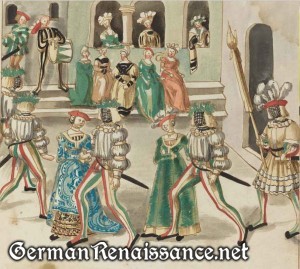



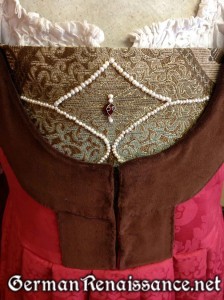
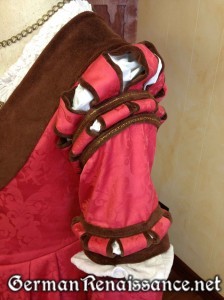
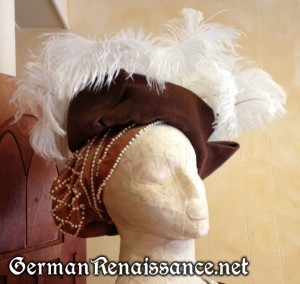
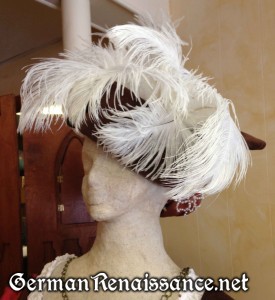
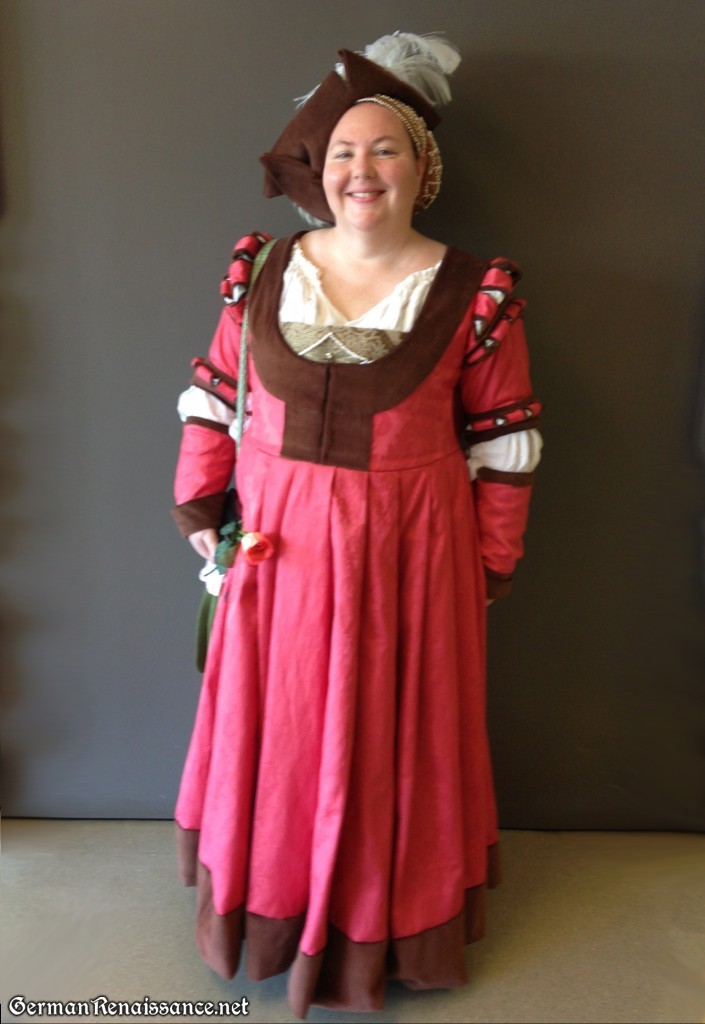
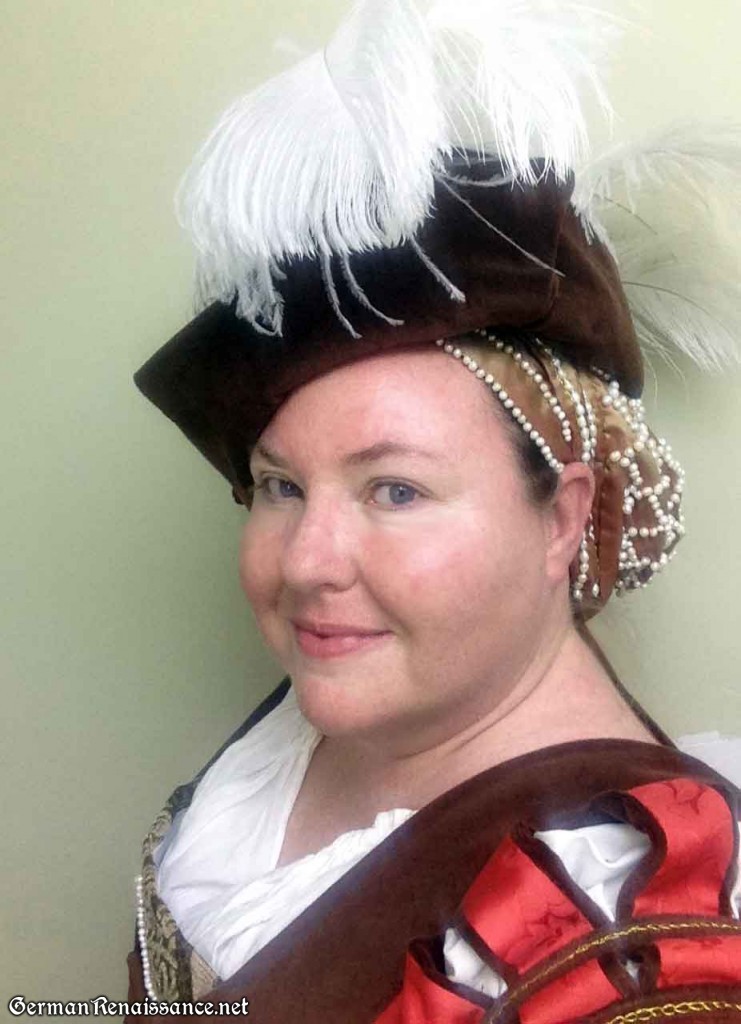

Very beautiful! and the dress also. The only thing I would add, other than your own suggestions, would be some gold threads to the smocking along with several gold chain necklaces in varing sizes. I very much enjoy your blogs.
This is so wonderful! Each dress just gets better and better! The pink really brings out your coloring! I knew that this dress would be nice from the prelim. pics., but this is better than expected.
I am never done with any of my own garb. I always think of ways to improve it after I wear it. You would think after 35 years of this I could do just one dress that is perfect from the get go. LOL!
At Joann’s I found (in the jewelery section), the perfect chain. It was a series of chains (with the really large links)That are supposed to be a component piece. I took my little pliers took the pieces apart and made one long piece out of the three.
Get two or three (your honey will want one too). My husband took one look at mine and ran off with it. A Viking at heart. LOL I should have known. Over the years he has been off with all of my good long chains with large links. Men got to love em! LOL!!!
I really LOVE this dress and you look great in it too!
Cate
Please tell me how you made the hat! I’ve been trying to figure it out and can’t get my head around it. Also, for the red and black Cranach-style gown, where do you hide the opening in the skirt?
I need to write up a tutorial for the brown hat — I think I took photos of it as I made it. As for the red and black Cranach-style gown, the opening in the skirt is right under the left edge of the bodice and is held closed with a hook and eye. (Updated: Here’s the tutorial: http://germanrenaissance.net/german-split-brim-beret-hat-tutorial/)
Thanks! Any chance you could email me the hat photos? I was hoping to make it…well…tomorrow…to wear this weekend…I do everything last minute!
Ask and ye shall receive — I wrote you a tutorial WITH photos! http://germanrenaissance.net/german-split-brim-beret-hat-tutorial/